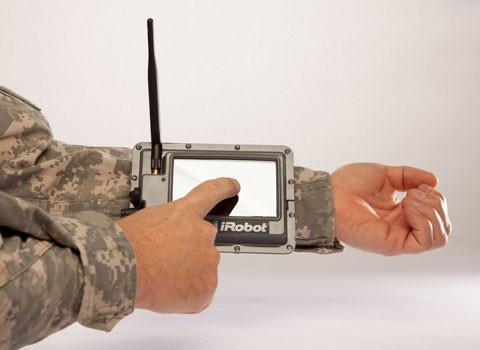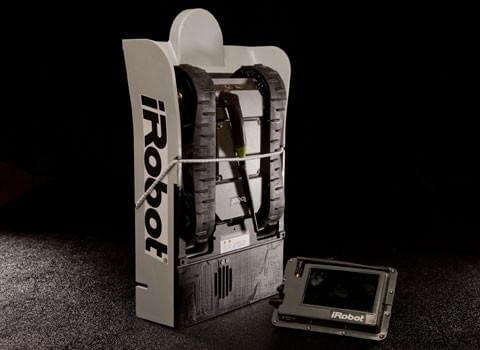iRobot’s Latest Military Bot Is a Pocket-Sized Spy Tank You Can Throw (video)

Share
It takes a lot of courage to run into a firefight. It takes a lot of robotics to not have to. iRobot recently unveiled the 110 FirstLook a small, lightweight, throwable robot that soldiers can use to get an advanced point of view without exposing themselves to more danger. The treaded FirstLook comes with two flipper-like limbs that allow it to prop itself up so that it can easily climb over short obstacles - such as stairs up to 8 inches high. Its cameras provide a nearly 360 degree view which can be sent back to a wrist mounted touchscreen which doubles as the means of controlling the robot. Watch the FirstLook in action in its debut video. This is the latest example of how the soldiers of the future will augment themselves with robots to provide an edge in battle.
FirstLook's specs are impressive. The robot is only 10 inches by 9 inches by 4 inches when its flippers are retracted, and it weighs less than 5 pounds. The bot can climb steps or other vertical obstacles up to 8 inches high, will survive a 15 foot drop onto concrete, and is waterproof down to 3 feet. Top speed is a fairly zippy 3.4 miles per hour. In other words, it's light enough to throw a long ways, strong enough to survive the shock, and if can't go over an obstacle it's fast enough to go around it. Whether it's in a tunnel, over dunes, or in abandoned buildings, FirstLook can get to where you need it to be.
Once it's there, you'll virtually be there as well. Its cameras are mounted to give you a full view around the robot, and it has IR illumination for low-light or no-light observation. FirstLook also comes equipped to handle two-way audio, so you can listen in to what's happening or use the bot to relay messages to people in the field. Despite running all these gadgets, FirstLook can run for six hours on its battery charge...or it can last 10 hours for passive observation if it is sitting still.
One of the coolest parts of the FirstLook is the way you drive it. The operator control unit (OCU) is a wrist mounted touchscreen. It's unclear if FirstLook will use point and go commands, or a more traditional control scheme, but either way the wrist mounted controls are a nice touch for a device that is supposed to be easily deployable by armed soldiers in the field. Not that the applications end there. As with many of these military spy bots, FirstLook could eventually find more use with fire departments, bomb squads, and disaster relief workers. Small, go-anywhere, robots make sense for those groups as well.
As well designed as FirstLook appears to be, I'm a little nonplussed by its arrival. This robot seems like old news. Northrop Grumman released a robot you could throw two years ago. The Eye Drive had a similar mission strategy (toss it into battle, remote view through it, get the drop on the enemy) though it had different specs as far as battery life, speed, robustness, etc (some better some worse). But let's forget about external competitors, doesn't FirstLook seem awfully close to iRobot's own Ember prototype it unveiled back in 2009? Small treaded robot with flippers and cameras...sure sounds familiar. iRobot hasn't announced pricing or availability for the FirstLook yet, but unless it costs $100 and has thousands of units ready to ship (those were some of the original plans for the Ember) I'm not going to be overwhelmed with enthusiasm.
Be Part of the Future
Sign up to receive top stories about groundbreaking technologies and visionary thinkers from SingularityHub.


Whether or not FirstLook is arriving late to the game may be besides the point. No matter who actually ends up making the bot that gets adopted by the US military, the concept behind Ember/FirstLook/Eye Drive is sound. Soldiers in the field need an extra set of eyes. RC airplanes move too fast and can't go inside buildings, quadrotor drones simply don't have the battery life for missions more than 30 minutes. A treaded spybot is the right solution for now, especially if it can be easily carried and deployed in the field. (I think we can agree that 'throwing' is a very easy method of deployment.) While they haven't released the effective range of FirstLook, iRobot has said that it could communicate with other FirstLook units in the field. Perhaps even forming an effective communications network? That would be nice, and something that is still years away in airborne drones.
As robots like FirstLook become available to soldiers, I'm sure that those men and women will jump at the opportunity to bring them into the field. Anything that helps them survive and do their jobs better is certainly welcome. Eventually we could see soldiers not simply augmented by robotic helpers, but effectively replaced by robots for many missions. We've seen this to some degree with Predator/Reaper drones, and it's likely to continue with armed ground robots as that technology improves and becomes more available. Hopefully when that happens these machines will be used in ways that quickly ends conflicts and limits the casualties of war. Military bots are cool to look at, but it's always sad when our technology helps us kill each other. Do your duty and then come home, FirstLook, there are about a thousand more fun ways I can think of using you that don't involve gunfire.
[image and video credits: iRobot]
Related Articles

These Robots Are the Size of Single Cells and Cost Just a Penny Apiece

In Wild Experiment, Surgeon Uses Robot to Remove Blood Clot in Brain 4,000 Miles Away

A Squishy New Robotic ‘Eye’ Automatically Focuses Like Our Own
What we’re reading


